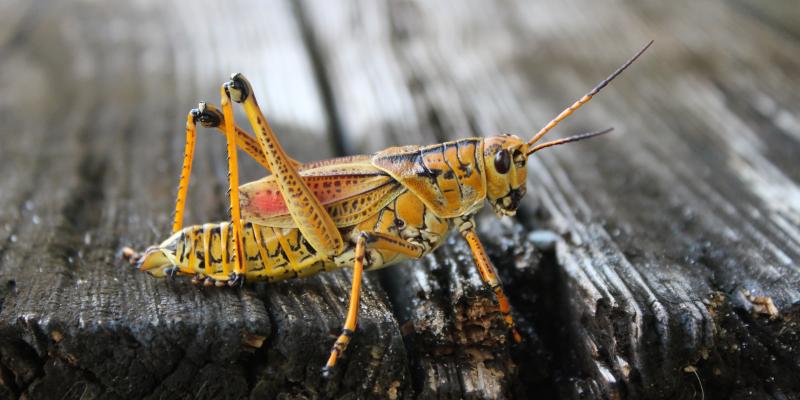Is the Eastern Lubber Grasshopper Poisonous? A Detailed Look

The Eastern Lubber Grasshopper is a notable critter in Florida, and their colors might lead you to believe they are poisonous. Known for their clumsiness compared to their other grasshopper cousins, these grasshoppers can sometimes be a nuisance to homeowners and their gardens. But are they a serious threat to you or your home? Read on to find out!
Orange Pest Control can help you if you’ve got a serious grasshopper infestation. Contact us today if you need help from the pros!
What Does the Eastern Lubber Grasshopper Look Like?
Diving into the world of the Eastern Lubber Grasshopper, Romalea microptera or Romalea guttata, reveals a creature of remarkable size and color diversity. Native to the southeastern United States, these grasshoppers stand out not only for their physical attributes but also for their unique defense mechanisms. Here's a closer look:
Size and Appearance:
- Adults: Can reach up to 9 cm, making them the largest grasshoppers in the U.S. Males average 6.0 cm, while females are larger at 8.0 cm. Their robust bodies and relatively slender legs contribute to their distinctive silhouette.
- Color Phases: Their coloration varies significantly, ranging from dull yellow with black spots, bright orange with black markings, to entirely black or black with yellow or red striping. This variability aids in camouflage and predator deterrence.
- Wings: Despite their well-developed wings, adults are flightless. The forewings extend two-thirds to three-fourths the length of the abdomen, with hind wings too short to provide lift.
Defense Mechanisms:
- The Eastern Lubber Grasshopper's bold colors act as a warning signal to potential predators, indicating their toxicity. These grasshoppers do produce a mild toxin to repel predators, which makes them a pretty unpleasant snack.
- If these grasshoppers feel threatened, they hiss, spread their wings, and secrete a foul-smelling froth to scare off predators. Pretty nasty critters, but it’s an effective deterrent.
Eastern Lubber Grasshopper Infestations
Despite the Eastern Lubber Grasshopper's intimidating appearance and defense mechanisms, their impact on agriculture and landscaping is typically localized but can be significant. Addressing infestations requires a strategic approach:
Integrated Pest Management (IPM) Techniques:
- Manual Removal: Effective but labor-intensive, especially when populations are high.
- Mowing: Keeping grass short reduces habitat suitability for lubbers.
- Chemical Control: Insecticides are more effective on nymphs. Recommended products include carbaryl, bifenthrin, permethrin, and spinosad. Apply according to label directions, focusing treatment along potential entry points to prevent migration into crops or gardens.
Habitat Management:
- Weed Control: Minimize weeds in open fields and pine areas to deter lubbers.
- Drainage Ditch Maintenance: Regular upkeep of drainage areas reduces preferable lubber habitats.
Insecticide Application:
- Early Intervention: Apply insecticides when lubbers are in the nymph stage for better control.
- Baits: Use bran bait mixed with corn oil and insecticide to attract and kill lubbers.
- Focused Treatment: Apply insecticides in strips along the margins of affected areas to create barriers against lubber migration.
Effective management combines early detection, habitat modification, and selective use of insecticides, ensuring minimal impact on non-target species and the environment.
The Eastern Lubber Grasshopper's Impact on Homeowners
For homeowners, the Eastern Lubber Grasshopper poses a unique challenge, especially for those passionate about their gardens and landscaping. Here's a closer look at the impact and control measures:
Impact on Home Gardens:
- Vegetable Damage: These guys love their leafy greens! They eat lettuce, peas, kale, beans, and cabbage.
- Floral Foliage: In flower beds, amaryllis, crinum, and lantana are among their favorites, leading to significant defoliation and aesthetic damage.
Control Measures:
- Physical Removal: At low densities, hand-picking Eastern Lubber Grasshoppers and disposing of them in soapy water is effective.
- Insecticides for Nymphs: Spinosad is effective against nymph stages, while a granular bait containing 5% carbaryl works against all stages.
Take a deep look into the Eastern Lubber Grasshopper’s diet to make a plan for your pest control measures. Their habits can inform you on where to put traps and spray deterrents!
Got a grasshopper infestation in your Florida yard and aren’t sure how to get rid of it? Contact Orange Pest Control, and we can help you get these hopping creeps gone for good.
